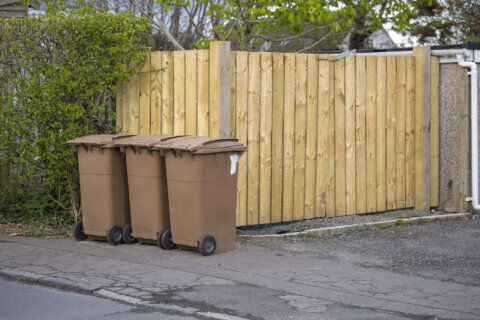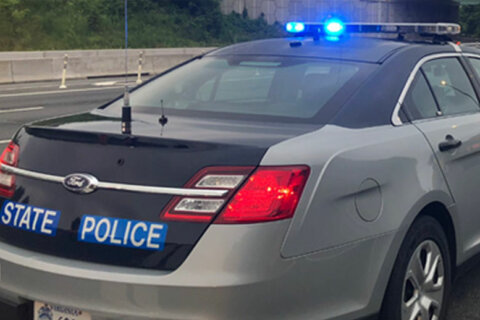Amid the flurry of activity after new Virginia Gov. Glenn Youngkin’s executive order allowing parents to have their children opt-out of a school system’s mask mandate, Prince William County School Board Chairman Babur Lateef is calling for state and local public health and education leaders to work together to develop metrics for a safe, scientifically-based “masking off-ramp.”
Lateef is seeking a measured, public-health based compromise, with the eventual goal of reducing — and ultimately eliminating — masking.
- More Prince William County Public School News
- More Prince William County News
- More Virginia News
- More Education News
“My highest priority, although not everyone is happy with me, is to keep kids in school — even with a mask — but I would like us to find an exit strategy, or what we call an off-ramp,” Lateef told WTOP. “I’m hopeful the governor’s new medical advisory team will be able to provide a road map toward getting rid of masks.”
Although Youngkin’s executive order takes effect Monday, Jan. 24, Lateef said he believes tweaking COVID-19 mitigation strategies will take some time, thought and collaboration.
“We can’t just decide, ‘We’re going to lift the mask order,'” said Lateef. “We need metrics to help us reduce masking.”
Lateef, and state senator Chap Petersen, a Democrat, from Fairfax City, wrote an Op-Ed in the Richmond Times-Dispatch, calling for “the state government to find those metrics and start outlining them for school divisions as guidance for how we should get rid of masking.”
As an example, Lateef points toward Massachusetts, where public health and school leaders looked for other mitigation strategies, with the goal of freeing students from the discomfort, educational and social constraints of masking.
“If 80% of people in the building there were vaccinated, teachers and students, they went mask-optional, so they had a road map there for everyone to aim for,” said Lateef. “I think, if we all work together, we can find some of those road maps as well, that we can all agree on, that all sides can sit down and say, ‘I can live with that.'”
Prince William County Public Schools is joining other Northern Virginia school divisions in declaring the school system will maintain its current mask mandates on Jan. 24, when Youngkin’s Executive Order 2 goes into effect.
In addition, local school leaders are considering legal challenges to Youngkin’s order.
“Like any contentious issue in American politics, this is going to end up in a courtroom,” said Stephen Farnsworth, a political-science professor at the University of Mary Washington.
Lateef, an eye surgeon, who was elected to serve as the board chairman in November 2019, is supportive of Superintendent LaTaynya McDade’s announcement on Monday, that the school division will continue masking, while reviewing Youngkin’s order and anticipated guidance from Virginia’s Department of Education.
This is not the first time Lateef has been willing to consider strong steps, in an attempt to approximate a return to a pre-pandemic normal for Prince William County students.
“I was criticized heavily for bringing special ed students back, in September 2020, long before the vaccine, and we did it successfully, with the heroic efforts of our teachers. That experience guided us to say we’re OK to bring our first and second graders in November, our third and fourth grades in January,” of 2021, far earlier than most school systems in Northern Virginia.
Most challenges to Youngkin’s executive order will focus on Virginia Senate Bill 1303, signed by former Gov. Ralph Northam, which mandated in-person learning. As part of the final compromise, school boards were required to follow Centers for Disease Control and Prevention guidance “to the maximum extent practicable” in bringing students back for in-person learning.
Lateef said school districts have previously taken safe, measured steps — for instance, shortening physical distance requirements to facilitate all students returning to classrooms and buses, as well as shortening quarantine periods.
With the priority of maximizing the number of days students are in-person, Lateef said leaping into a mask-free school environment wouldn’t work.
“If we just go ahead and remove masking, that throws us backward on the quarantining, and that creates far more days missed,” Lateef said.
“I, more than anyone, would like to see us get rid of masks, but there has to be an orderly process, based on sound scientific principles to do so.”
Part of the challenge, Lateef said, is that the CDC hasn’t provided data to allow school systems to draw blueprints for a mask off-ramp.
“CDC has to look at how the rest of the country is doing, put those studies together and say, ‘We have districts that have been mask optional and we have not seen the spread,'” Lateef said. “Share the data, let’s work on that data together, because we can reassure our public, ‘Look, folks, this is working elsewhere, there’s no reason why it won’t work here.'”








